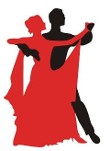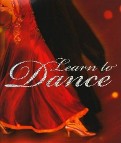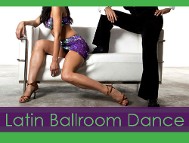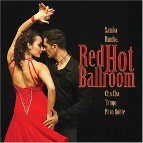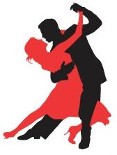The Dances Defined
DanceTime Dances
Argentine Tango
This style of Tango originated in the streets and salons of Buenos Aires
and is characterized by its passionate hold and complex leg and foot
movements.
Bolero
A slow Latin dance which originated as one of two forms of Rumba (Bolero
Rumba and Son Rumba), and still shares many of the same figures.
Bolero differs from Rumba in its tempo and style of music and movement.
Cha Cha
An exciting, syncopated Latin dance which originated in the 1950's as a
slowed-down Mambo. The Cha Cha gets its name and character from its
distinct repetitive foot rhythm, 1-2-3 step-step which is similar to Swing.
Perfect 10: The cha cha cha By Marianka Swain
East Coast Swing
Also called American or Triple Step Swing due to the rhythm of the basic
triple step, this dance consists of six and eight count patterns. It is a
circular dance that is danced with a bounce and is very grounded and
not high in the legs. This bounce requires the dancer to stay very smooth
and not jump around much. East Coast Swing, derived from Lindy Hop
and Jitterbug, is the base for all swing dances.
Foxtrot
A smooth dance introduced to the public in 1913 by Harry Fox, noted for
being the first dance to incorporate into the rhythm a combination of Slows
and Quicks. Foxtrot is characterized by smooth, walking style movements,
but can be adapted to fit a variety of musical tempi and style, or to fit onto
small, crowded nightclub dance floors.
Perfect 10: The foxtrot By Rachelle Stretch
Hustle
Often associated with retro disco music, the hustle is the perfect dance
for dance-beat, nightclub music including everything from pop to rap and hip hop. Do the Hustle.
Jive
The European version of the East Coast Swing, this dance uses six and
eight count patterns. However, it is danced quite bouncy with very sharp
foot kicks and "flicks," to faster tempo swing music and is meant for
competitive style dancing. Perfect 10: The jive By Rachelle Stretch
Mambo
A fast Latin dance, similar to Salsa, which comes from Cuba. Mambo was
brought to America in the 1940's and 50's and eventually adapted as an
American style ballroom dance. Most of the movements emphasize the
second beat in the measure, suggestive of the Clave rhythm which is
fundamental to Mambo music.
How the mambo became the cha-cha-cha By Patsy Holden
Merengue
An energetic Latin-style march which originated in the Dominican Republic,
which emphasizes a straight-ahead 8-count rhythm taken with Cuban Motion.
Merengue is now also a subset of the modern club-style Salsa dances.
Night Club Two Step
An easy-going social dance, similar in movement to the Bossa Nova, first
introduced in the 80's by Buddy Schwimmer and popular amongst the
West Coast Swing crowd. Nightclub 2-Step is normally danced to
medium-tempo pop songs and ballads, using combinations of
Slow-Quick-Quick and Quick-Quick-Slow rhythms.
Paso Doble
A dramatic French-Spanish Flamenco-style march danced in 2/4 time, with
man portraying the matador in a bullfight, the lady as his cape. The character
of the dance is arrogant and passionate. The History of the Paso Doble.
Peabody
A dance developed in the United States around 1920, which was created as
a fast version of the Foxtrot characterized by rapid progression and frequent
use of Right Outside Position and locking actions.
Quickstep
The dance began as a quick version of Foxtrot mixed with the Charleston,
and musical "Jazz" influences. It is characterized by fast movement, often
including a variety of hops, kicks, skips, lock steps and chassés.
Perfect 10: The quickstep By Claire Saul
Rumba
A Latin dance characterized by Cuban motion done to romantic Latin songs
and music, the Rumba is a slow, sensuous, romantic dance which spotlights
the lady and features much flirtation.
Perfect 10: The rumba By Alison Gallagher-Hughes
Salsa
A hot Latin dance similar to Mambo, which, when danced correctly, displays
a lot of shaking, shimmying, and hip action.
Samba
This is the official dance of Brazil. Characterized by "bounce" action, it is
danced to fast music in 2/4 time. Perfect 10: The samba By Rachelle Stretch
Tango
The Tango originated in Argentina. A progressive dance that moves along
the line of dance, it is characterized by staccato movements of the feet
and flexed knees, and stylized poses that highlight its dramatic style.
The History of the Tango.
Viennese Waltz
A fast ballroom dance in 3/4 or 6/8 meter, often associated with the music of
Johann Strauss. The History of the Viennese Waltz.
Waltz
The oldest and best known of all the Ballroom dances, Waltz is a progressive
dance using rise and fall and danced to 3/4 Time music.Slow Waltz evolved
from the fast paced Viennese
Waltz. The History of the Waltz.
West Coast Swing A slotted swing dance in 4/4 time, characterized by its
smooth and linear style.
Swing Dancing
Whether you call it Swing, Jitterbug, Jive, hand-dancing, Shag East Coast,
West Coast or Lindy, it falls under the general term Swing dancing. One of
the popular lines is "It's not Swing without a smile!" Swing is a fun-loving
dance which makes people happy! Swing Dancing your first dance will not
give you formal pictures of a wedding waltz, but it will set the reception off
with a bang! In the USA, Swing is probably the most socially useful dance.
The rhythm of the dance lends itself well to a large number of musical styles.
You can dance Swing to Jazz, Big Band, Country, Rock and Pop.
Swing is a truly American Dance which has world wide appeal. It presumably
originated in the 1920's with the Jazz and Swing bands and Swing Dancing
was as rebellious as listing to the music. Movies like "Swing Kids" give some
idea of how powerful the trend was. Every generation issues in a new revival
in Swing of some kind because it is FUN!
Single Swing - Basic timing: Slow Slow Quick Quick. Best suited up tempo
music like big band and upbeat Pop and Rock. The footwork is very simple.
It's a lot like learning to drive an automatic instead of a stick shift
(see Triple Swing).
Triple or East Coast Swing - Basic timing: 1&2 3&4 5 6. It is a dance well
suited to Jazz, Rock and Country music. Very popular, especially in ballroom
studios. Modern music is much slower than the old Big Band tunes so this
variant is much more commonly taught in general. The style is very free
and easy. The dance patterns also tend to be more circular in nature.
Lindy - Basic timing: 12 3&4 5&6. Named after Charles "Lindy" Lindberg
the great American aviator, Lindy is very popular in the Virginia and DC
metropolitan area. We enjoy teaching this dance because of the fun
charleston kicks and lifts associated with it. While the dance can be danced
in a circular fashion like in East Coast Swing, in this area the "slotted" style
is preferred. The dancing couple exchanges positions with each other,
rotating about 180 on each step. It is very much like West Coast Swing.
West Coast Swing - Basic timing: 12 3&4 5&6 It is a dance well suited to
Jazz, Rock and Country music. West Cost Swing is also very popular in the
DC metropolitan area. It is also very slotted in its form but more complicated
in the footwork than Lindy, with a particular focus on the connection and
timing in 8's. West Coast is often danced to very fast music that could also
be danced as Hustles, but personal preference is to dance it slowish blues.
It also tends to have a jazzier, sexier feel that the fun-loving East Coast
Swing variety and this is reflected in the styling.
